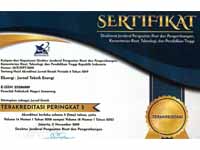TINJAUAN RINGKAS TEKNOLOGI GASIFIKASI PLASMA DALAM PENGOLAHAN LIMBAH PADAT MENJADI ENERGI BARU TERBARUKAN
DOI:
https://doi.org/10.32497/eksergi.v17i2.2620Keywords:
Sampah, Teknologi termal, Gasifikasi plasma, Syngas, ListrikAbstract
Permasalahan sampah di Indonesia masih banyak menimbulkan masalah sosial dan lingkungan, sehingga aplikasi teknologi yang mampu menangani tingginya volume sampah semakin mendesak untuk diaplikasikan. Solusi teknologi termal dalam penanggulangan sampah yang tersedia saat ini masih membutuhkan kajian kelayakan untuk dapat diterapkan di Indonesia. Salah satu teknologi termal yang telah banyak di aplikasikan di berbagai negara adalah gasifikasi plasma. Gasifikasi plasma merupakan suatu metode efektif dalam menguraikan berbagai senyawa organik dan anorganik menjadi elemen-elemen dasar dari sebuah senyawa. Proses gasifikasi plasma meliputi: Feed Handling, Plasma Gasification, Pendingin, kompresi, dan pembersihan sintetik gas (syngas). Gasifikasi plasma dapat mengubah material sampah organik menjadi syngas yang dapat digunakan untuk menghasilkan energi yang efisien dan memenuhi kebutuhan listrik.Downloads
Published
Issue
Section
License
Authors who publish with this journal agree to the following terms:Authors retain copyright and grant the journal right of first publication with the work simultaneously licensed under a Creative Commons Attribution License that allows others to share the work with an acknowledgement of the work's authorship and initial publication in this journal.
Authors are able to enter into separate, additional contractual arrangements for the non-exclusive distribution of the journal's published version of the work (e.g., post it to an institutional repository or publish it in a book), with an acknowledgement of its initial publication in this journal.
Authors are permitted and encouraged to post their work online (e.g., in institutional repositories or on their website) prior to and during the submission process, as it can lead to productive exchanges, as well as earlier and greater citation of published work (See The Effect of Open Access).






